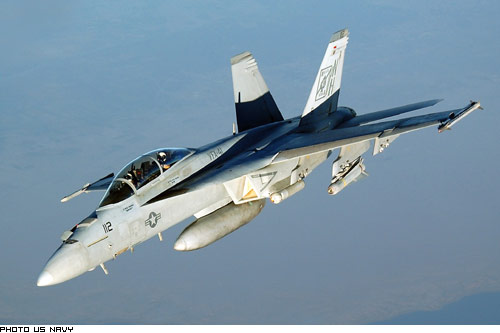F/A-18 E/F Super Hornet
Summary
| Category | Combat Aircraft |
| Origin country | 🇺🇸 United States |
| Manufacturer | Boeing |
| First flight | 29 November 1995 |
| Year introduced | 2001 |
| Number produced | 632 units |
| Average unit price | $57 million |
Description
The F/A-18E/F Super Hornet emerged from the U.S. Navy's need to replace the canceled A-12 Avenger II and the aging A-6 Intruder, while also addressing the combat radius limitations of the legacy F/A-18 Hornet. Originally conceived by McDonnell Douglas in the 1980s as the "Hornet 2000," the Super Hornet was selected as a lower-risk and more affordable alternative to clean-sheet designs or costly upgrades to the F-14 Tomcat, especially following post-Cold War budget cuts. Developed as a derivative, it was largely a new aircraft designed to be a mainstay for carrier air wings. The Super Hornet first flew on 29 November 1995, with low-rate production starting in March 1997 and full-rate production commencing in September of that year after McDonnell Douglas merged with Boeing. The program successfully met cost, schedule, and weight targets, achieving initial operating capability with the U.S. Navy in 2001.
A significant redesign of the original Hornet, the Super Hornet is approximately 20% larger, with a 25% greater wing area and 33% more internal fuel capacity, which increases its mission range by 41%. Key aerodynamic changes include enlarged leading-edge extensions (LEX) for improved high-angle-of-attack handling and rectangular caret engine inlets to accommodate the more powerful General Electric F414 engines. The design incorporates radar cross-section reduction features, including S-duct-style intakes that shield the fan blades and aligned panel join serrations. Its avionics suites have evolved through successive Block upgrades, incorporating the AN/APG-79 AESA radar, Joint Helmet Mounted Cueing System (JHMCS), and advanced defensive systems like the AN/ALQ-214 IDECM. A notable capability is its configuration as a tactical airborne tanker using an external air-to-air refueling system, or "buddy store."
The Super Hornet is equipped with a comprehensive weapons suite centered around an internal 20 mm M61A2 Vulcan rotary cannon. Its eleven hardpoints can carry a maximum payload of 17,750 lb (8,050 kg). For air-to-air missions, the aircraft can be armed with missiles such as the AIM-120 AMRAAM and the AIM-9 Sidewinder. Its air-to-surface arsenal is extensive, including munitions like the AGM-88 HARM anti-radiation missile, AGM-84 Harpoon anti-ship missile, AGM-154 Joint Standoff Weapon (JSOW), and both Joint Direct Attack Munition (JDAM) and Paveway series of guided bombs. For external fuel and specialized equipment, it can carry up to five external tanks and targeting pods like the AN/ASQ-228 ATFLIR or reconnaissance pods.
The Super Hornet entered combat service with the U.S. Navy on 6 November 2002, conducting strikes over Iraq during Operation Southern Watch. It has since been used extensively in major conflicts, including Operation Iraqi Freedom and Operation Enduring Freedom in Afghanistan, performing close air support, strike, SEAD, and airborne refueling missions. A notable engagement occurred on 18 June 2017, when a U.S. Navy F/A-18E shot down a Syrian Su-22 fighter-bomber. The Royal Australian Air Force has also deployed its F/A-18F variants for combat, commencing operations against IS militants over Iraq in 2014. More recently, U.S. Navy Super Hornets have engaged Houthi targets in the Red Sea.
Main Variants
- F/A-18E: The single-seat variant of the Super Hornet.
- F/A-18F: A tandem-seat variant configured for a pilot and a weapon systems officer.
- EA-18G Growler: An electronic warfare variant of the F/A-18F, developed to replace the U.S. Navy's EA-6B Prowler.
- Advanced Super Hornet: A proposed upgrade featuring conformal fuel tanks, a reduced radar cross-section, and an optional enclosed weapons pod.
- NEA-18G: Two F/A-18F airframes that were modified to serve as prototypes for the EA-18G Growler program.
Technical specifications
| Version: F/A-18E/F | |
|---|---|
| Crew | 1 (F/A-18E) or 2 (F/A-18F) |
| Operational range | 2,346 km (1,458 mi) |
| Maximum speed | 1915 km/h (1190 mph) |
| Wing area | 46.5 m² (500.5 sqft) |
| Wingspan | 13.6 m (44.7 ft) |
| Height | 4.9 m (16.0 ft) |
| Length | 18.3 m (60.1 ft) |
| Service ceiling | 15,940 m (52,297 ft) |
| Empty weight | 14,550 kg (32,077 lbs) |
| Max. takeoff weight | 29,900 kg (65,918 lbs) |
| Climb rate | 228.0 m/s (748.0 ft/s) |
| Powerplant | 2 × General Electric F414-GE-400 turbofans |
| Ejection seat | Martin-Baker Mk 14 |
Current operating countries
All operators
Armament
Missiles payload:
- Air-to-Surface AGM-65 Maverick
- Air-to-Surface AGM-84 Harpoon
- Anti-Radiation AGM-88 HARM
- Air-to-Air Medium-Range AIM-7 Sparrow
- Air-to-Air Medium-Range AIM-120 AMRAAM
- Air-to-Surface Raytheon AGM-154 JSOW
- Air-to-Air Short-Range Raytheon AIM-9 Sidewinder
Bombs payload:
- Cluster Aerojet CBU-78/B Gator
- Cluster Aerojet CBU-87/B CEM
- Thermonuclear Livermore B83
- Cluster Mk 20 Mod 0 Rockeye
- Cluster Textron CBU-97/B SFW
